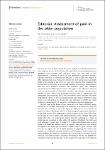Editorial: Assessment of pain in the older population
| dc.contributor.author | Schofield, P | |
| dc.contributor.author | Gnass, I | |
| dc.date.accessioned | 2024-03-25T10:56:36Z | |
| dc.date.available | 2024-03-25T10:56:36Z | |
| dc.date.issued | 2023 | |
| dc.identifier.issn | 2673-561X | |
| dc.identifier.issn | 2673-561X | |
| dc.identifier.other | ARTN 1249762 | |
| dc.identifier.uri | https://pearl.plymouth.ac.uk/handle/10026.1/22219 | |
| dc.description.abstract |
For many years now we have proposed that pain is regularly assessed and fundamental to the management process. To date, there has been a great deal of research exploring the most appropriate pain assessment tools and great strides have been made in their implementation. Assessment of pain in the older population has presented challenges, especially when there are communication difficulties, as seen in adults with dementia or other communication issues. Pain is not a natural part of the ageing process and people should not be expected to live with it. In recent years, there has been recognition that stoicism does not mean there is no pain and a number of behavioural pain assessment tools have been developed, evaluated, and introduced widely, with widespread implementation of validated pain assessment. The papers in this collection examine the issues of pain assessment in older adults and those with dementia, moving forward thinking on these subjects and presenting innovative ways of implementing pain management using technology. The COVID 19 pandemic resulted in many older adults being isolated at home, so they consequently became more isolated. Furthermore, many services were disbanded in the UK and staff were reallocated to COVID areas which resulted in a reduced number of pain services and therefore increased waiting times. | |
| dc.format.extent | 1249762- | |
| dc.format.medium | Electronic-eCollection | |
| dc.language | eng | |
| dc.publisher | Frontiers Media SA | |
| dc.subject | pain assessment in older adults | |
| dc.subject | pain behaviour | |
| dc.subject | dementia | |
| dc.subject | technology-enabled solution | |
| dc.subject | familiy members | |
| dc.title | Editorial: Assessment of pain in the older population | |
| dc.type | Journal Article | |
| plymouth.author-url | https://www.ncbi.nlm.nih.gov/pubmed/37692329 | |
| plymouth.volume | 4 | |
| plymouth.publication-status | Published online | |
| plymouth.journal | Frontiers in Pain Research | |
| dc.identifier.doi | 10.3389/fpain.2023.1249762 | |
| plymouth.organisational-group | |Plymouth | |
| plymouth.organisational-group | |Plymouth|Research Groups | |
| plymouth.organisational-group | |Plymouth|Faculty of Health | |
| plymouth.organisational-group | |Plymouth|Faculty of Health|School of Nursing and Midwifery | |
| plymouth.organisational-group | |Plymouth|REF 2021 Researchers by UoA | |
| plymouth.organisational-group | |Plymouth|Users by role | |
| plymouth.organisational-group | |Plymouth|Users by role|Current Academic staff | |
| plymouth.organisational-group | |Plymouth|REF 2021 Researchers by UoA|UoA03 Allied Health Professions, Dentistry, Nursing and Pharmacy | |
| plymouth.organisational-group | |Plymouth|Research Groups|Plymouth Institute of Health and Care Research (PIHR) | |
| plymouth.organisational-group | |Plymouth|REF 2029 Researchers by UoA | |
| plymouth.organisational-group | |Plymouth|REF 2029 Researchers by UoA|UoA03 Allied Health Professions, Dentistry, Nursing and Pharmacy | |
| dc.publisher.place | Switzerland | |
| dcterms.dateAccepted | 2023-07-10 | |
| dc.date.updated | 2024-03-25T10:56:35Z | |
| dc.rights.embargodate | 2024-03-28 | |
| dc.identifier.eissn | 2673-561X | |
| rioxxterms.versionofrecord | 10.3389/fpain.2023.1249762 |


